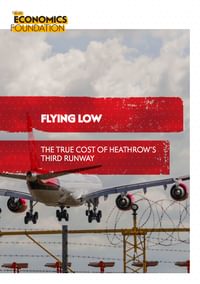Flying low
The true cost of Heathrow's third runway
27 March 2018
Afresh examination of the economic case for a third, north west runway at London’s Heathrow airport finds it eroded to the point where it is no longer viable. Now, using the Government’s own formula for assessing the value for money of transport schemes, Heathrow expansion along proposed lines would be rated as either ‘poor’ or ‘low’ value.
MPs, who will debate the building of a third runway at the airport in Parliament in the coming months, must now ask significant questions of the Government, the Department for Transport (DfT), and the airport before giving the scheme their support. On the basis of this review’s economic assessments of London airports expansion, we question whether the vote should even go ahead.
At best, in net present value terms, building the North West Runway (NWR) at Heathrow will yield an economic benefit of £3.3 billion. At worst, in net terms there would not only be no economic benefit whatsoever, but a significant financial cost of up to £2.2 billion, to be borne either by the airport, its investors, airlines, passengers or perhaps even government.
Given the high proportion of new passengers – three-quarters by 2040 – that will use Heathrow as a hub, starting and finishing their journeys outside the UK, it is also unlikely that nations and regions of the UK will see significant benefit, with promised new domestic connections perhaps only viable with government support. In fact according to the latest projections, building the NWR will lead to lower passenger numbers at regional airports than if there were no South East expansion.
Worsening economic cost-benefit
In July 2015, the independent Airports Commission launched its final report, recommending Heathrow’s NWR as its preferred means of expanding capacity in the south east of England. In terms of net present value (NPV) – the cost-benefit metric the Government usually uses to assess the economics of infrastructure projects – the Commission’s central economic assessment was that building the runway would yield £11.8 billion of benefit.
But updated modelling by the DfT, published in October last year to support the government’s National Policy Statement (NPS) on aviation, significantly revises this down due to changes in a variety of modelling assumptions and now finds that in NPV terms the scheme is expected to deliver between minus £2.2 billion and plus £3.3 billion in economic benefits.
While complex, the reasons for such a large difference between the Airports Commission’s cost-benefit conclusions in 2015 and the DfT’s in 2017 are mostly accounted for by two changes in modelling. First, the Commission’s modelling of wider economic benefits, especially those of trade and clustering, has been dramatically re-appraised by the DfT due to concerns about double counting and the risk of excluding negative effects. Second, there has been a narrowing of the gap between the benefits that are expected to be enjoyed by passengers versus those captured by airlines, due to changes in modelling assumptions.
Earlier, the DfT also dispensed with whole sections of economic modelling upon which one section of the Airports Commission’s report relied and which yielded some of the more eye-catching economic projections published upon its launch in 2015.
Heathrow NWR would now be rated as either poor or low value.
According to the Government’s updated assessment for the NPS, not only has the economic case for Heathrow NWR been significantly eroded but, at its median and lower bounds, is now worse than the Gatwick second runway (2R) (£1 billion to £2.4 billion). While the case for Gatwick is hardly compelling, and Heathrow’s upper bound still better, with a wider range of cost-benefits, and higher environmental disbenefits, Heathrow is arguably also the riskier of the two.
Significantly, according to the DfT’s own value for money criteria for transport infrastructure projects, Heathrow NWR would now be rated as either poor or low value.
But it could be worse still
The New Economics Foundation (NEF) has reviewed all of the past and present modelling – using the publicly available data from sources such as the Airports Commission, DfT and underlying modelling by other firms and organisations – and finds that, taking other significant factors into account, the economic case for Heathrow’s NWR could be even worse; perhaps wholly negative.
Taking other significant factors into account, the economic case for Heathrow’s NWR could be even worse; perhaps wholly negative.
Most significantly, as Heathrow is a hub airport, the benefits that accrue to passengers that begin and complete their journey in another country (known as international to international passengers or I‑to‑I) and use the airport only as a hub, should not be included as a benefit in the economic assessment of the NWR. This is because the money these passengers save on cheaper tickets – the NWR’s main purported economic benefit to consumers (or consumer surplus) – does not accrue as welfare in the UK economy.
In 2040, three-quarters of the new passengers able to use an expanded Heathrow airport are forecast to be I‑to‑I and using Heathrow as a hub. Excluding these passengers from the DfT’s most recent assessment –something the DfT itself recommends – reduces the NWR’s NPV by a further £5.5 billion, resulting in an NPV ranging from minus £2.2 billion to a worst case of minus £7.7 billion.
But the economic case for Heathrow could be eroded further still. For instance, a critical factor is the amount the airport charges airlines for its use and how much of this is passed on to passengers by the airlines. Heathrow is already one of the world’s most expensive airports for airlines – based on average per passenger aeronautical charges – and has not ruled out increases to reflect the costs of constructing its NWR. Even before subtracting I‑to‑I consumer benefits, a demand response from passengers to the resulting higher fares would result in NWR’s NPV falling to minus £3.9 billion to plus £1.6 billion.
If the project faces construction or legal delays or other delays due to local protest, or if the price of emitting carbon is higher than forecast, then Heathrow NWR faces further loss of benefit.
None of these factors are, in and of themselves, unlikely. A perfect storm in which they interact could see Heathrow NWR’s economic cost-benefits pushed further and further into negative bounds.
Who wins and who loses
UK nations and regions have supported the Airports Commission’s recommendation in favour of Heathrow on the basis that it delivers benefits across all areas of the UK. But are they right to do so?
The theory goes that Heathrow will open up more routes for regional airports, with passengers hubbing through an expanded Heathrow, and reduce ticket prices both on these connecting routes and in general.
But as the economic case for Heathrow erodes, and with the high number of additional passengers travelling I‑to‑I, the benefits distributable across the UK economy necessarily narrow. People located closer to Heathrow, though bearing most of the environmental impact costs of Heathrow, are arguably better positioned to capture the benefits of airport expansion, than those outside of London and the South East.
According to the NPS, the government expects to see six new routes from UK airports to Heathrow or Gatwick as a result of expansion, bringing their total domestic connections to 14 and 12 respectively. But Heathrow has said it will not provide guarantees for even a minimum number of UK connections; instead it has suggested it will make it economic for airlines to fly domestic routes and has urged the Government to change the way it mandates ‘Public Service Obligation’ routes from their current ‘city-to-city’ status to ‘airport-to-airport’.
This may be of benefit to Heathrow and to some passengers, but could have a deleterious effect on other airports and could also mean government ultimately subsidising operators to use the expanded airport.
Overall by 2040, it is predicted that the scheme will lead to a reduction in 14 million passenger numbers at non-London airports.
Significantly, while the NPS has forecast 5.9 million extra international passenger trips from regions outside London and the South East using Heathrow NWR by 2040, this statistic ignores the drop in international traffic using regional airports. Overall by 2040, it is predicted that the scheme will lead to a reduction in 14 million passenger numbers at non-London airports.
Expanding airports in the South East is, at its core, all about changing the status quo in which the constraint on slots provides opportunities for airlines that already fly into and out of Heathrow to capture many of the existing benefits. Freeing up slots through expansion should therefore create more benefit for consumers in terms of cheaper fares (because of greater supply of take-off and landing slots and more competition) as well as savings in travel times and more scheduled flights.
But the case for Heathrow is no longer as it was originally presented by the Airports Commission:
- Economic modelling for the Airport Commission’s ‘strategic case’, which produced some of the big GDP benefits cited in press reports at launch, is now discredited and should not be used.
- Subsequent changes in economic assumptions made in between July 2015 and the publication of the DfT’s updated appraisal report in October 2017 have reduced Heathrow’s projected NPV from £11.8 billion to between minus £2.2 billion and plus £3.3 billion.
- Stripping out the benefits that accrue to I‑to‑I passengers – which mostly do not accrue in the UK – erodes Heathrow NWR’s cost-benefits by up to a further £5.5 billion.
- A range of other factors, such as if Heathrow’s aeronautical charges increase and are passed through to passengers, could reduce the lower bound of Heathrow’s cost-benefit to an even more significant minus number.
- The stated benefits to UK connectivity may be significantly overstated, with regions outside of London actually experiencing an overall reduction in aviation traffic.
- On the basis of these findings, we question whether a planned Parliamentary vote on the scheme in the coming months should even go ahead. It seems clear to us that Heathrow’s proposed NWR is no longer economically viable in net terms and indeed the DfT’s own method for scoring such projects would seem to rule it out.
- If the NPS does proceed into Parliament, then in considering whether to approve it or not, MPs should take all these factors into account.
Campaigns Stop airport expansions
Topics Industrial strategy Transport







